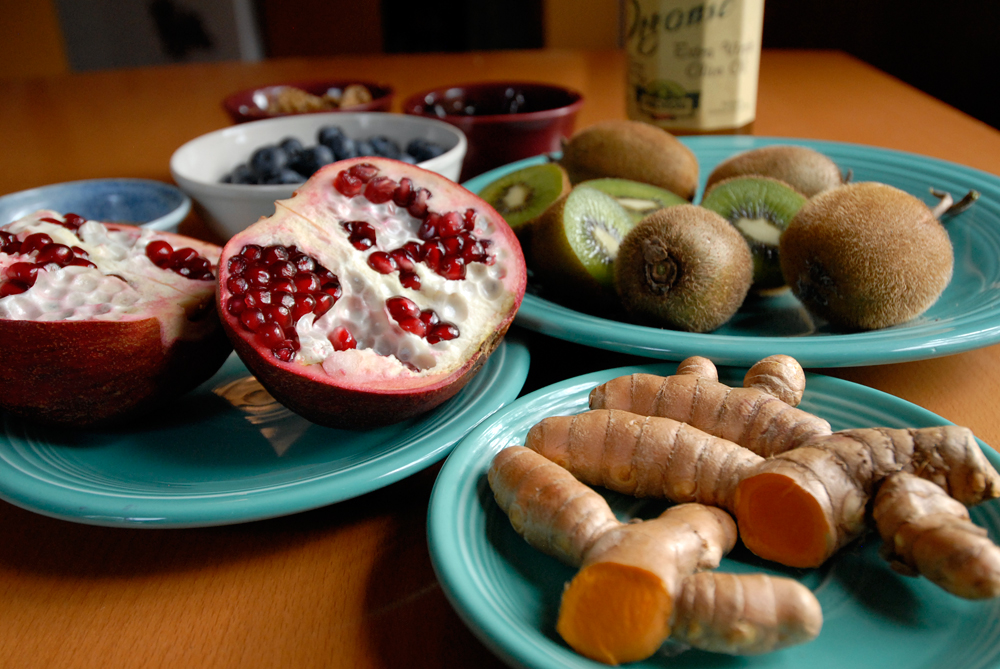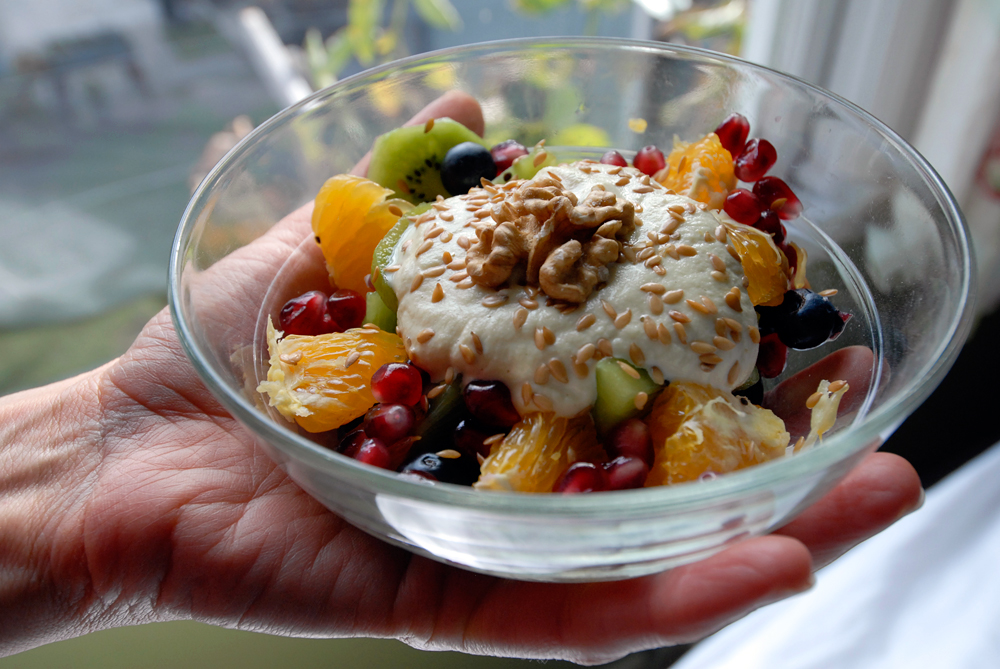All Photos: Wendy Goodfriend
Excess inflammation is a major cause of disease in our modern times. It is linked to diabetes, cancer, heart disease, arthritis and even the aging process. This makes reducing inflammation one of the most important ways to promote health and longevity. Luckily our diet play a key role in controlling the inflammatory process and everyday food choices can make the difference between health and disease. It’s not complicated, the equation is simple. By avoiding the foods that promote inflammation and consuming the foods that decrease inflammation we can reduce our risk with each meal!
The first step is to eat a diet rich in organic, unrefined foods. Many whole foods have anti-inflammatory properties because they have beneficial fiber, vitamins and minerals. However, some stand apart, possessing powerful medicinal properties. Below I have listed my five favorite foods to reduce inflammation, prevent diseases and retard the aging process. Not only are these foods rich in nutrition, they are rich in flavor.
-
Five foods that reduce inflammation
- Turmeric
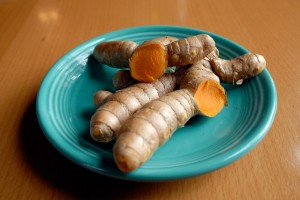 This Asian spice is a medicinal superfood. Turmeric (Curcuma Longa) is a relative of ginger and is the spice that gives curry powder its characteristic yellow color. It is one of the most extensively researched medicinal spices. It protects the liver from toxins and is effective in killing numerous bacteria and yeasts. It is also and exceptional anti-inflammatory. Studies indicate that one of the most important constituents in turmeric is the yellow pigment, curcumin. It blocks several inflammatory chemicals reducing inflammation throughout the body. It is easy to consume turmeric daily by adding it to curries, beans, rice, sauces or smoothies. Just be careful because curcumin is so powerful that is stains everything -- clothing, towels and countertops. Turmeric is available as a dried powder or as the fresh root which resembles yellow ginger. It is best absorbed when it is combined with black pepper, or other aromatic spices as it is in traditional curry.
This Asian spice is a medicinal superfood. Turmeric (Curcuma Longa) is a relative of ginger and is the spice that gives curry powder its characteristic yellow color. It is one of the most extensively researched medicinal spices. It protects the liver from toxins and is effective in killing numerous bacteria and yeasts. It is also and exceptional anti-inflammatory. Studies indicate that one of the most important constituents in turmeric is the yellow pigment, curcumin. It blocks several inflammatory chemicals reducing inflammation throughout the body. It is easy to consume turmeric daily by adding it to curries, beans, rice, sauces or smoothies. Just be careful because curcumin is so powerful that is stains everything -- clothing, towels and countertops. Turmeric is available as a dried powder or as the fresh root which resembles yellow ginger. It is best absorbed when it is combined with black pepper, or other aromatic spices as it is in traditional curry. - Flax seeds and other rich sources of omega-3 fatty acids
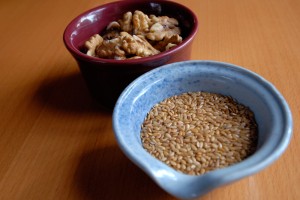 In our bodies, cells communicate with each other by sending chemical messengers into the blood stream. These messengers are called cytokines. Certain cytokines promote an inflammatory response, while others turn it off. Omega-3 fatty acids cause more of the anti-inflammatory cytokines to be made. The modern American diet is very low in omega-3 fatty acids. It is difficult to get enough of them without making a conscious effort to eat high omega-3 foods. Flax seeds are one of the best vegetarian sources of omega-3s. Other rich sources are cold-water fish, hemp seeds, walnuts, chia seeds and grass-fed beef.
In our bodies, cells communicate with each other by sending chemical messengers into the blood stream. These messengers are called cytokines. Certain cytokines promote an inflammatory response, while others turn it off. Omega-3 fatty acids cause more of the anti-inflammatory cytokines to be made. The modern American diet is very low in omega-3 fatty acids. It is difficult to get enough of them without making a conscious effort to eat high omega-3 foods. Flax seeds are one of the best vegetarian sources of omega-3s. Other rich sources are cold-water fish, hemp seeds, walnuts, chia seeds and grass-fed beef. - Berries
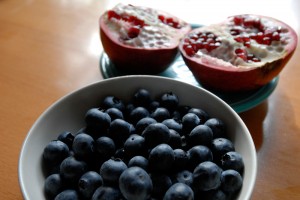 Berries have a wide range of health benefits from anti-cancer effects to improving wound healing. One of their most important properties is their ability to reduce inflammation. This property has been studied in different types of berries as well as in similar fruit such as pomegranate and cherries. It is easy to eat a variety of berries regularly as they tend to be accessible and are delicious. In the winter frozen berries are a good option. Freezing and thawing the fruit actually makes the powerful flavonoid compounds more available. Berries can be eaten in smoothies, fruit salads, desserts or straight from the bowl.
Berries have a wide range of health benefits from anti-cancer effects to improving wound healing. One of their most important properties is their ability to reduce inflammation. This property has been studied in different types of berries as well as in similar fruit such as pomegranate and cherries. It is easy to eat a variety of berries regularly as they tend to be accessible and are delicious. In the winter frozen berries are a good option. Freezing and thawing the fruit actually makes the powerful flavonoid compounds more available. Berries can be eaten in smoothies, fruit salads, desserts or straight from the bowl. - Kiwis and other high enzyme foods
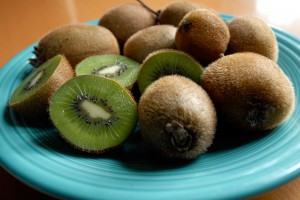 Enzymes are one of the oldest natural remedies for inflammation. Bromelain, an enzyme rich extract from the pineapple fruit, has been used by the medical community for over 50 years. The most effective enzymes seem to be the ones that break down proteins. These are found abundantly in several fruits like kiwi, pineapple and green papaya. When consumed raw, a portion of these enzymes are absorbed intact into the blood stream where they break down inflammatory complexes. For acute conditions highly concentrated supplements are often used. But for low-grade chronic inflammation food is an important part of prevention and healing. Kiwis are a winter fruit in California. They are available in most stores, or you can pick your own organic kiwis at Swanton Farms in Pescadero.
Enzymes are one of the oldest natural remedies for inflammation. Bromelain, an enzyme rich extract from the pineapple fruit, has been used by the medical community for over 50 years. The most effective enzymes seem to be the ones that break down proteins. These are found abundantly in several fruits like kiwi, pineapple and green papaya. When consumed raw, a portion of these enzymes are absorbed intact into the blood stream where they break down inflammatory complexes. For acute conditions highly concentrated supplements are often used. But for low-grade chronic inflammation food is an important part of prevention and healing. Kiwis are a winter fruit in California. They are available in most stores, or you can pick your own organic kiwis at Swanton Farms in Pescadero. - Olives and extra virgin olive oil
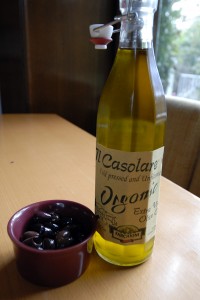 The Mediterranean diet is well known to promote health and longevity. This is largely due to the high consumption of olives and extra virgin olive oil. These oily fruits are packed with anti-inflammatory polyphenols that have been shown to reduce both arthritis and heart disease. However, these important phytochemicals are not present in the refined oil. So remember to use the extra virgin, cold-pressed oil or the whole olives.
The Mediterranean diet is well known to promote health and longevity. This is largely due to the high consumption of olives and extra virgin olive oil. These oily fruits are packed with anti-inflammatory polyphenols that have been shown to reduce both arthritis and heart disease. However, these important phytochemicals are not present in the refined oil. So remember to use the extra virgin, cold-pressed oil or the whole olives.
Try the simple recipe below for wintertime treat.
